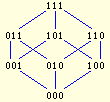Isoperimetric Tools
Computing the ball size
For a graph G and a subset A of its vertices denote by
Bdry(A) the set of vertices of the complement that are at distance
1 from A. Furthermore, denote by Ball(A) the ball around
A, i.e. the union of A and Bdry(A).
This tool computes and displays the boundary of a subset of GxH.
The graphs G and H are defined by their ball-sequences.
The i-th element of such sequence is the minimum size of the ball
around a set of size i, for i=1, 2, ... , |G|.
We assume here that the graphs are connected. This means that the
ball-sequence is not decreasing, and the i-th entry is at
least min(i+1, |G|), for i=1, 2, ... ,
|G|.
The ball-sequence does not specify the graph uniquely. Moreover, not
any ball-sequence satisfying the above properties is realized by some
graph. However, any such sequence is realized by an oriented graph. In this
case the boundary is defined as the set of vertices that can be reached
from A by outgoing edges. The oriented graph is obtained by
connecting the vertex i with the vertices 1, 2, ..., Ball(i)
for i=1, 2, ... , |G|.
Enter the ball-sequences into the corresponding text input fields
(separate its entries by spaces) and click the "Show GxH" button.
You will see a grid with each cell corresponding to a vertex of GxH
with G represented by columns and H by rows. The cell in the
bottom left corner represents the vertex (1,1). Clicking a cell toggles its
belonging to the set, which is indicated by coloring the cell in blue.
The boundary vertices are shown in green.
You also can upload one or both files and combine uploading with
entering the ball-sequences. The graph encoding instructions are at the
bottom of this page. In case of uploading of at least one file, use
the "Browse..." button, then click "Upload" button, and then "Show GxH".
If one of the files does not need to be uploaded, just leave its field
empty. Entering a ball-sequence followed by "Enter" key will reset the file
data for this graph.
Graph encoding instructions
The graphs are encoded by using the adjacency list represenation.
The graph file is a text (ASCII) file with the number of lines equal to the
number of vertices, that is one line per vertex. For each vertex
v of G the corresponding line must contain the following
information:
label
label1 label2 . . .
labelk
Here:
label is the label of v
(a string consisting of letters, digits or the underscore symbols "_"
only)
label1 label2 . . .
labelk is a list of labels of vertices advacent
with v. Isolated vertices are not allowed.
Moreover, the file must satisfy the following claims:
- The file size must not exceed 50 kilobytes.
- The parameters within one line must be separated by one or more spaces.
- Empty lines are ignored.
- A portion of a line followed by the # sign is considered as a comment
and ignored. The comments are optional.
Example
| Graph | Encoding | Comments |
|---|
 |
000 001 010 100 # the bottom vertex
001 000 011 101 # first level
010 000 011 110
100 000 101 110
011 001 010 111 # second level
101 001 100 111
110 010 100 111
111 011 101 110 # the top vertex
|
empty line, ignored
vertex with label 001 is adjacent
to vertices with labels 000,
011, and 101
the top vertex is advacent to 3 vertices
|
Last modified:
Mon, Jan 23, 2023.
